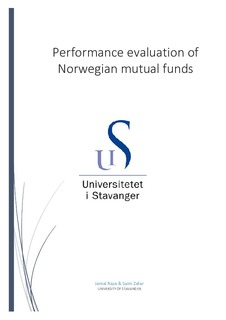| dc.contributor.advisor | Lin, Tao | |
| dc.contributor.author | Raza, Jamal | |
| dc.contributor.author | Zafar, Saim | |
| dc.date.accessioned | 2018-09-25T07:44:18Z | |
| dc.date.available | 2018-09-25T07:44:18Z | |
| dc.date.issued | 2018-06 | |
| dc.identifier.uri | http://hdl.handle.net/11250/2564214 | |
| dc.description | Master's thesis in Applied finance | nb_NO |
| dc.description.abstract | This study analyses the performance of different Norwegian mutual funds that have invested the majority of their equity in the Norwegian stock market during the period of January 2007 to January 2018. The purpose of this thesis is to investigate whether the fund managers possess stock picking- and market timing ability and how the funds performed during the different market events, both for the whole period and the sub-periods. The market events included in the data are; The Financial Crisis, The EU Debt Crisis, The US Credit-Rating Downgrade and The Oil Crisis. Moreover, this study investigates whether the best performing fund in one period is consistent with the best performing fund in the next period. The whole period is divided into shorter periods, which allows further evaluation of mutual funds during bull- and bear markets.
The quantitative fund performance evaluation is conducted by using different performance measurements and regression analyses. The regression analyses reflect whether the fund managers possess significant stock picking- and market timing ability. A total of 10 Norwegian mutual funds are compared and ranked, all with Oslo Stock Exchange Mutual Fund Index (OSEFX) as their benchmark.
For the whole period, Fondsfinans Norge was concluded to be the overall best performing fund and the only fund with both significant stock picking- and market timing ability. However, there were other funds that obtained significant stock picking ability, but none of these funds had significant market timing ability. Among the bottom-performing funds, Holberg Norge and Eika Norge are the only funds to obtain significant and negative alpha´s in period 2, suggesting significant underperformance relative to the benchmark. The fact that the top- and bottom-performing funds in the sub-periods were different in each period leads to the conclusion that the winner in one period is not consistent with the winner in the next period. Considering the different market events, all of the funds decreased in their performance, especially during The Financial Crisis. | nb_NO |
| dc.language.iso | eng | nb_NO |
| dc.publisher | University of Stavanger, Norway | nb_NO |
| dc.relation.ispartofseries | Masteroppgave/UIS-HH/2018; | |
| dc.rights | Navngivelse 4.0 Internasjonal | * |
| dc.rights.uri | http://creativecommons.org/licenses/by/4.0/deed.no | * |
| dc.subject | økonomi | nb_NO |
| dc.subject | administrasjon | nb_NO |
| dc.subject | anvendt finans | nb_NO |
| dc.subject | Oslo Børs | nb_NO |
| dc.title | Performance evaluation of Norwegian mutual funds | nb_NO |
| dc.type | Master thesis | nb_NO |
| dc.subject.nsi | VDP::Samfunnsvitenskap: 200::Økonomi: 210::Bedriftsøkonomi: 213 | nb_NO |

